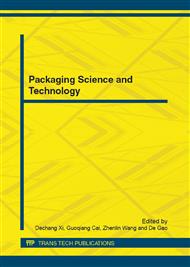p.300
p.305
p.312
p.316
p.321
p.325
p.331
p.335
p.339
Effects of Coupling Agents on the Mechanical Properties of the Calcium Carbonate-Plastic Composite Packaging Materials
Abstract:
Mechanical properties of the calcium-plastic composite have a great influence on the containers. The main factors affecting the mechanical properties are the process and material formulations. This paper mainly describes its impact of the addition of coupling agent. Under the usage of analysis of variance on single factor experiment, the mechanical properties of the calcium carbonate-plastic composite with three different coupling agents (silane, titanate and aluminate) were studied in the same test conditions. The results show that: The type and quantity of the coupling agent effect a lot on the mechanical properties of the composite. The silane coupling agent is the most suitable for calcium carbonate-plastic composite packaging materials, and the compatibility of calcium carbonate and polyethylene can be improved. When the silane coupling agent was at a 2.25 wt. % concentration, the tensile and flexural strength were improved obviously, especially the tensile strength increased by 23.24%, but the impact strength improved slightly.
Info:
Periodical:
Pages:
321-324
Citation:
Online since:
October 2012
Authors:
Price:
Сopyright:
© 2012 Trans Tech Publications Ltd. All Rights Reserved
Share:
Citation:


